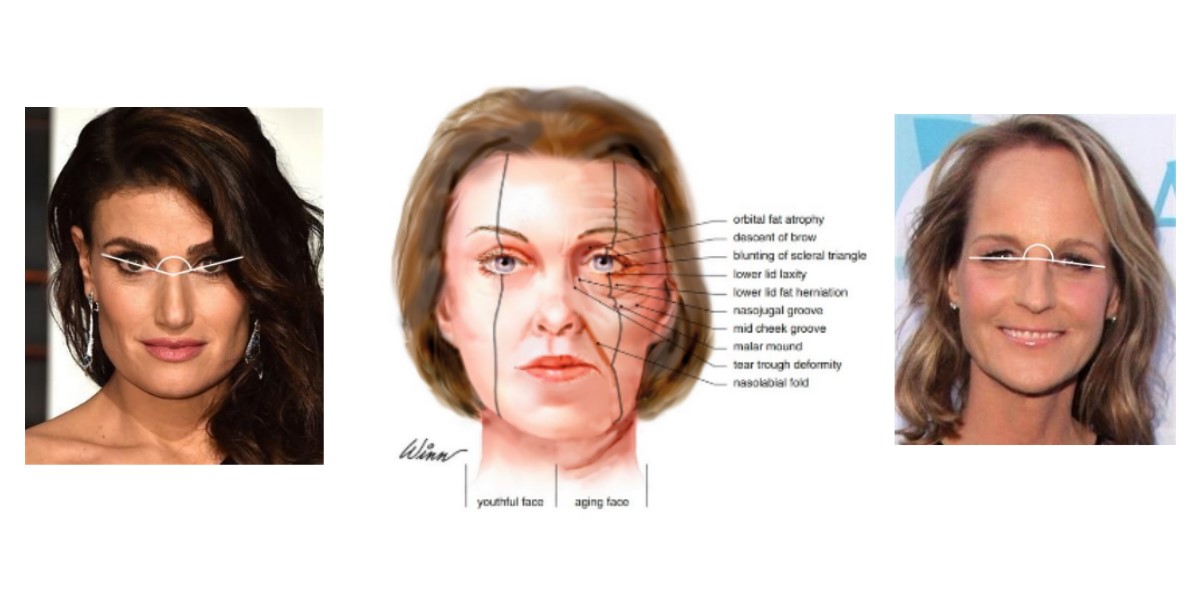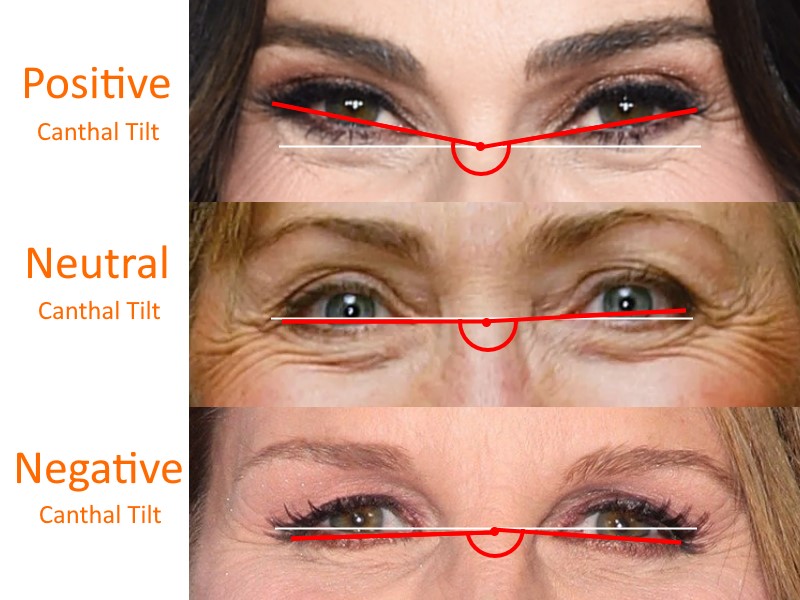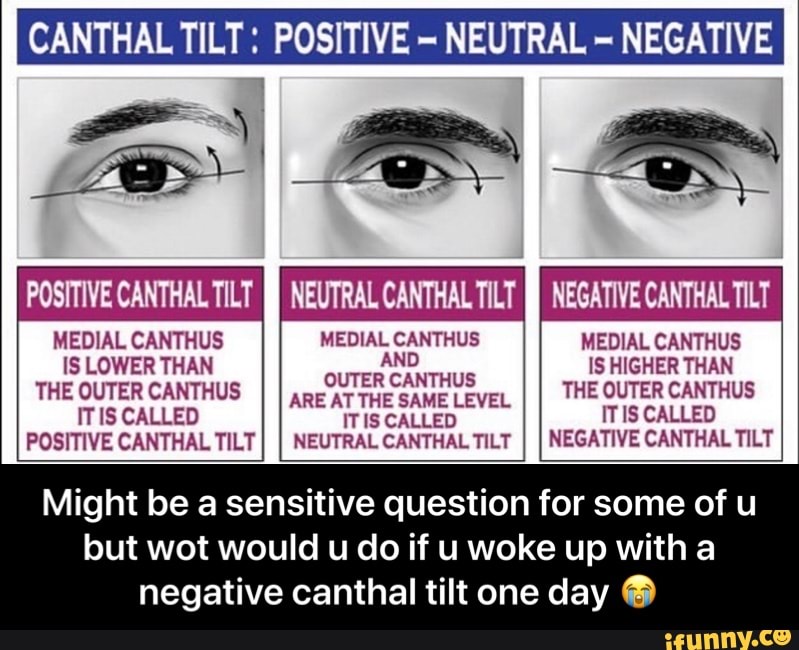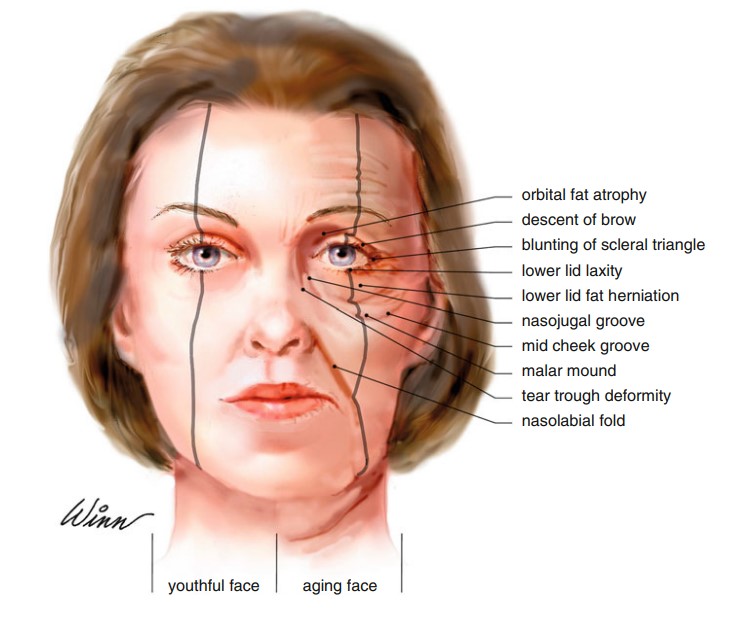
Is The Fox Eye Look Always In Season? The Research Behind Medial Canthal Tilt in Facial
Types of Canthal Tilt. A person's canthal tilt can be classified as positive, neutral, or negative, depending on the angle between the canthi. Women with attractive eyes generally have a positive canthal tilt, which means, ideally, a slight tilt at a five- to eight-degree angle between the lateral and medial canthus.

What is an Eye canthal Tilt? Why is a positive tilt more attractive than a negative tilt among
After taking a picture, draw a line from the side of your eye to the middle of your eye on both eyes. You have a positive canthal tilt if your lateral canthus is higher than your medial canthus. The lines will look like a small V. If your canthal tilt is neutral, you will have a very close to a straight line.

What is an Eye canthal Tilt? Why is a positive tilt more attractive than a negative tilt among
Types of Canthal Tilt. To accurately evaluate facial proportions, it is important to have an understanding of the different types of canthal tilt. There are primarily three types: Positive Canthal Tilt. A positive canthal tilt refers to the upward slant created when the outer corners of the eyes are slightly elevated.

What is an Eye canthal Tilt? Why is a positive tilt more attractive than a negative tilt among
According to Dr. Ari Hoschander, a board-certified plastic surgeon and owner of KH Plastic Surgery, a positive canthal tilt "has the potential to enhance a person's feminine, attractive, and youthful appearance. Conversely, a negative canthal tilt may contribute to an older, more fatigued, and distressed look."

The canthal tilt (black line) is the line connecting the medial canthus... Download Scientific
"When you have a positive canthal tilt, it gives the impression that your eye is a little bit more open," explains Sachin M. Shridharani, MD, board-certified plastic surgeon at Luxurgery in.

CANTHAL TILT POSITIVE = NEUTRAL NEGATIVE MEDIAL CANTHUS MEDIAL CANTHUS MEDIAL CANTHUS IS LOWER
A positive canthal tilt is when the upper eyelid ends on a higher plane than does the lower. This type of canthal tilt may be hereditary, congenital, or acquired. It usually causes an eye to appear larger and with a subtle bulge. As a result, you may end up looking more attractive, youthful, and more feminine. 2.

The canthal tilt (black line) is the line connecting the medial canthus... Download Scientific
A positive canthal tilt Negative canthal tilt. When the inner corner of the eye is placed higher than the outer corner, it's a negative canthal tilt. It's typical for the prey eyes, making the glance softer. There's also a neutral canthal tilt when the lateral canthus is on the same level as the medial canthus.

What is your canthal tilt?
In most patients, the lateral canthal angle is positioned at 2 mm superior to the medial canthal angle. If a line is drawn between medial and lateral canthi, it will show an upward inclination to the lateral side. This is called positive canthal tilt. A negative canthal tilt is present when the medial canthus is superior to the lateral canthus.

Positive canthal tilt is overrated Men's SelfImprovement & Aesthetics
The canthal tilt refers to the positioning of your eyes and measures the tilt from the inner corner to the outer corner of your eyes. So if your eyes slant upwards, it's a positive tilt. If your eyes slant downward, it's a negative tilt. Dr. Ari Hoschander, a board-certified plastic surgeon, says that a positive canthal tilt "has the.

How to perform a lateral canthotomy EyeGuru
Social media may emphasize the importance of the positive canthal tilt, as it may help the eyes appear larger or more open, Lin said. As a result, some people might go as far as to getting surgery.

"A positive canthal tilt with lower eyelid lightly tilting upward along lateral canthus exudes
The ideal canthal tilt is typically thought to be a positive one, and it occurs when the medial canthus is 5-8 degrees below the lateral canthus. A negative canthal tilt can make one look aged or tired. However, depending on facial structure, a neutral tilt may also be ideal, as it typically makes the eye look larger and more neotenous.

The canthal tilt (black line) is the line connecting the medial canthus... Download Scientific
Summary The eye canthal tilt refers to the angle between the internal and external corners of the eyes. Research by Codner et al. (2008) has identified three types of canthal tilt: positive, neutral, and negative. Several studies have emphasized the significance of a positive canthal tilt in male attractiveness. Specifically, an article by Volpe and.

How to lift up corners of eyes Positive canthal tilt YouTube
This normally results in a "positive" canthal tilt or upward slant, creating an eye shaped like an almond. Canthoplasty surgery is used to correct canthal tilts that are negative or neutral and causes sagging eyelids, which may be causing distress to the patient who does not like the appearance of their eyelids.

Canthal Tilt Positive and Negative Tilt Ultimate Guide 2020
A positive canthal tilt gives one a more attractive, sharper, and younger look. According to a study held at the University of Toronto by Bashour & Geist (2007), canthal tilt is a power cue for female facial attractiveness. The possible explanation to this phenomenon as per Bashour & Gest is "The fact that palpebral fissure inclination is.

What is an Eye canthal Tilt? Why is a positive tilt more attractive than a negative tilt among
"A person with a positive canthal tilt is objectively defined as having a more youthful appearance than someone with a negative canthal tilt. When the outer corner of your eye is below the inner.

The canthus tilt is considered positive if the medial canthus angle ranges between 5 and 8
A canthal tilt, also known as the fox-eyed look, describes the angle between your inner eye and your outer eye. A positive canthal tint is when the outer corner of the eye is five to eight degrees higher than the inside corner. Conversely, negative means the outside corner of the eye is five to eight degrees lower than the inside corner. Twin.